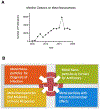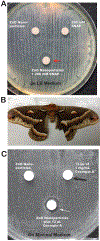Metal Nanoparticles in Infection and Immunity
- PMID: 32524902
- PMCID: PMC7554245
- DOI: 10.1080/08820139.2020.1776724
Metal Nanoparticles in Infection and Immunity
Abstract
Background Enthusiasm for the use of metal nanoparticles in human and veterinary medicine is high. Many articles describe the effects of metal nanoparticles on microbes in vitro, and a smaller number of articles describe effects on the immune system, which is the focus of this review. Methods Articles were retrieved by performing literature searches in Medline, of the National Institute of Medicine, as well as via Google Scholar. Results In vitro studies show that metal nanoparticles have antimicrobial effects. Some metal nanoparticles augment innate host immune defenses, such as endogenous antimicrobial peptides, and nitric oxide. Metal nanoparticles may also function as vaccine adjuvants. Metal nanoparticles can migrate to locations distant from the site of administration, however, requiring careful monitoring for toxicity. Conclusions Metal nanoparticles show a great deal of potential as immunomodulators, as well as direct antimicrobial effects. Before metal particles can be adopted as therapies; however, more studies are needed to determine how nanoparticles migrate though the body and on possible adverse effects.
Keywords: Gold; nitric oxide; silver; vaccine adjuvants; zinc.
Conflict of interest statement
Disclosure: The author has no competing interests or conflicts of interest to declare.
Figures


References
-
- Ansari MA, Khan HM, Khan AA, Sultan A, and Azam A. 2012. Synthesis and characterization of the antibacterial potential of ZnO nanoparticles against extended-spectrum beta-lactamases-producing Escherichia coli and Klebsiella pneumoniae isolated from a tertiary care hospital of North India. Applied Microbiology & Biotechnology. 94:467–477. - PubMed
-
- Babushkina IV, Gladkova EV, Belova SV, and Norkin IA. 2017. Application of Preparations Containing Copper Nanoparticles for the Treatment of Experimental Septic Wounds. Bulletin of Experimental Biology & Medicine. 164:162–164. - PubMed
-
- Bellinger DC 2016. Lead contamination in Flint—an abject failure to protect public health. New England Journal of Medicine. 374:1101–1103. - PubMed
Publication types
MeSH terms
Substances
Grants and funding
LinkOut - more resources
Full Text Sources
